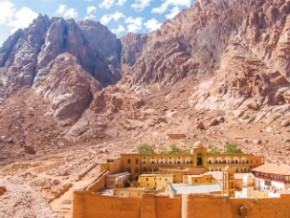The force of silence: Uneasy holiness in the Sinai desert

Every year I lead a weeklong “adventure into silence” in the South Sinai—something between a retreat and a seminar in the deep desert. Each year when I return I get two sorts of comments. The first, uttered in a variety of tones between loving concern and indignation, is along the lines of “were you safe?” This year that question had some reality behind it, for ten days after I flew back from Sharm el-Sheikh a Russian plane that took off from that city exploded, and the group Daesh–Sinai Province claimed responsibility.
The second comment I get is “I envy you that peace.” (Sometimes I get both comments from the same person, which is very odd.)
The answer to the first question, this year as every year, is simply yes. I would not go if I did not feel safe—in the sense of safe from terrorism, jihad, kidnap, decapitation, or other mayhem; I certainly would not take a group with me. I feel safe because I trust the locally connected tourist organization I travel with. And in fact until the airliner crash, South Sinai (unlike North Sinai) was peaceful. I feel safe and I have been safe. I will go again next year if nothing changes.




